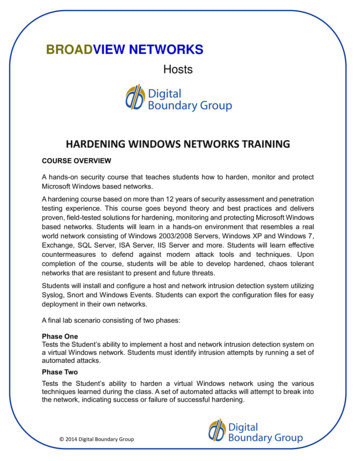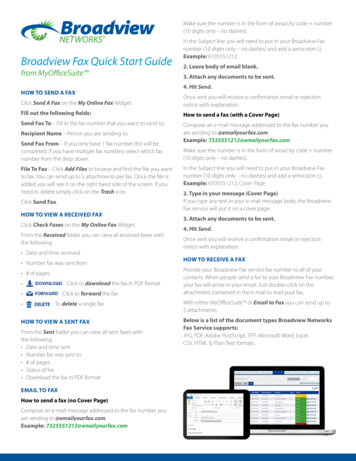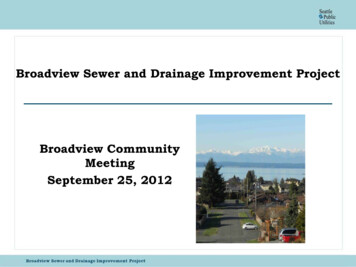
Transcription
BROADVIEW NETWORKSHostsHARDENING WINDOWS NETWORKS TRAININGCOURSE OVERVIEWA hands-on security course that teaches students how to harden, monitor and protectMicrosoft Windows based networks.A hardening course based on more than 12 years of security assessment and penetrationtesting experience. This course goes beyond theory and best practices and deliversproven, field-tested solutions for hardening, monitoring and protecting Microsoft Windowsbased networks. Students will learn in a hands-on environment that resembles a realworld network consisting of Windows 2003/2008 Servers, Windows XP and Windows 7,Exchange, SQL Server, ISA Server, IIS Server and more. Students will learn effectivecountermeasures to defend against modern attack tools and techniques. Uponcompletion of the course, students will be able to develop hardened, chaos tolerantnetworks that are resistant to present and future threats.Students will install and configure a host and network intrusion detection system utilizingSyslog, Snort and Windows Events. Students can export the configuration files for easydeployment in their own networks.A final lab scenario consisting of two phases:Phase OneTests the Student’s ability to implement a host and network intrusion detection system ona virtual Windows network. Students must identify intrusion attempts by running a set ofautomated attacks.Phase TwoTests the Student’s ability to harden a virtual Windows network using the varioustechniques learned during the class. A set of automated attacks will attempt to break intothe network, indicating success or failure of successful hardening. 2014 Digital Boundary Group
COURSE DETAILSStudents will harden a network consisting of:Microsoft ExchangeOutlook Web AccessMicrosoft ISA ServerMicrosoft IISMicrosoft Windows XP/ Windows 7Microsoft Windows Server 2003/2008Microsoft SQL ServerMicrosoft Software Update ServicesFirewallReview of Common Exploitation Techniques- Password Attacks- SQL Server Attack- Token Stealing Attack- Process Injection Attack- Remote Exploits- Client Side Exploits- Root Kits- PivotingInformation Gathering and Prevention- Null Session Enumeration- SID/Name Translation- NetBIOS Enumeration- SNMP- LDAP- DNSActive Directory Group Policies- Time Synchronization- Local Security Settings- Top 8 Local Security Settings necessary to secure a Windows network- Exploiting Windows systems before and after Local Security Settings hardening 2014 Digital Boundary Group
User Account and Password Management- Windows Password Hashing- User Rights- Least Privileged- Securing Local Administrator accounts- Securing Domain Administrator accountsAuthentication Mechanisms- Securing passwords at rest (LM, NTLM, LSA)- Securing passwords in motion (LM, NTLM, NTLMv2, Kerberos)Auditing- Default Windows auditing configuration- Configure auditing to capture security eventsEvent Logs- Default Windows event log configuration- Log retention, rotation and archiving- Event Log Analysis – Identifying security related eventsVulnerability Scanning Tools and Procedures- Nessus Vulnerability Scanner- GFI LANGuard- Microsoft Baseline Security Analyzer- Free and Open Source toolsLog Monitoring and Alerting- Converting Windows events to syslog events- Configure syslog to detect and alert on security events- Monitoring firewall eventsHost Intrusion Detection- Implement a host intrusion detection system using windows events and syslog 2014 Digital Boundary Group
Network Intrusion Detection- Implement a network intrusion detection system using firewall events and syslog- Install Snort intrusion detection software- Configure Snort as a network sensor and forward events to syslogSecuring Services and Service Accounts- Locate Service Accounts on a Network- Reduce or eliminate Domain Administrator privilege for service accounts- Process injection attack to elevate privilegesHost Firewall Configuration- Configure Microsoft firewall via GPO- Strategies to defend against network WormsNetwork Traffic Analysis- Using Wireshark to detect malicious activityProxy Server- Configure proxy settings via GPO- Analyze network attacks before and after proxy deploymentFile System Security- Share security vs. NTFS security- Distributed File System- Encrypted File SystemPatch Management Solutions- Deploying patches in a hardened Network- Patching with windows firewall enabled- Patching vs. HardeningSoftware Restriction Policy- How a software restriction policy can defeat many malicious attacks- Implement and test a simple but effective software restriction policy 2014 Digital Boundary Group
Software Deployment through Group Policy- Deploying software in a hardened network- Deploying software with Windows firewall enabledFinal Lab- Deploy host and network intrusion detection in a virtual windows network (Snort,syslog, Windows events)- Run automated attacks and identify the source, destination and type of attack- Harden a virtual Windows network- Run automated attacks to test windows hardening 2014 Digital Boundary Group
2014 COURSE DATE AND LOCATION:September 21-25 2015Broadview Networks1 – 1530 Taylor AvenueWinnipeg, ManitobaCOURSE COST: 2,975.00 applicable taxes (includes refreshments and lunches each day, coursematerials and course tool-kit)10% discount applied for two or more attending from the same company.CANCELLATION POLICY:If you must cancel, please provide written notification via email totraining@digitalboundary.net. Cancellations must be received at least 15 business days in advance of the coursestart date in order to avoid a 50% cancellation fee.If cancellation notice is received less than 5 business days in advance of thecourse start date, the cancellation fee will be 100%.No refund will be made for non-attendance on the course.Please Note: Business day means every day of the week except Saturday, Sunday andStatutory Holidays. 2014 Digital Boundary Group
IF WE CANCEL YOUR COURSEOccasionally it may be necessary for Digital Boundary Group to cancel your course (i.e.if registrations do not reach a required level). In this event, we will give you at least 5business days’ notice of the cancellation and will offer an alternative date. If thealternatives given are not convenient, you may cancel your registration at no charge.Terms and Conditions:1.2.3.4.Payment of the course registration fee, plus applicable taxes, is required to bereceived, at the address listed on the registration form, 15 business days inadvance of the scheduled start of the course in order to complete theregistration process.Course fees must be paid by cheque made payable to Digital Boundary Group.Confirmation of registration will only be made on receipt of full payment of thecourse fees and applicable taxes.CANCELLATION POLICY: Please refer to aboveThe International Information Systems Security CertificationConsortium, Inc. accepts Digital Boundary Group’s Security TrainingProgram as credit toward meeting the Continuing ProfessionalEducation requirements to maintain the Certified InformationSystems Security Professional (CISSP) designation (CISSPConstituents will earn 32 CPE credits) 2014 Digital Boundary Group
Hardening Windows Networks Training RegistrationCourse InformationCourse Location:Broadview Networks1 – 1530 Taylor Avenue Winnipeg MB R3N 1Y1Course Dates:Course Price:April 29 – May 2 2,975.00 applicable taxesRegistrationName:Position:Name of Organization:Address of Organization:Telephone:Cell Phone:Fax:E-mail:Industry:Fax completed registration to:OR(204) 984-9899(519) 652-8660Or mail completed registration and payment to:Broadview NetworksOR1- 1530 Taylor AvenueWinnipeg, ManitobaR3N 1Y1Digital Boundary Group4226 Raney CrescentLondon, OntarioN6L 1C3For more information please call:1-800-747-3557 ext. 248 2014 Digital Boundary Group
September 21-25 2015 Broadview Networks 1 - 1530 Taylor Avenue Winnipeg, Manitoba COURSE COST: materials and course tool-kit) 10% discount applied for two or more attending from the same company. CANCELLATION POLICY: If you must cancel, please provide written notification via email to training@digitalboundary.net.










